| Portrait
|
Name
|
Term
|
Position
|

|
John Langdon
|
April 6–21, 1789
|
President pro tempore
|
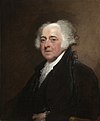
|
John Adams
|
April 21, 1789 – March 4, 1797
|
President of the Senate
|

|
Thomas Jefferson
|
March 4, 1797 – March 4, 1801
|
President of the Senate
|

|
Aaron Burr
|
March 4, 1801 – March 4, 1805
|
President of the Senate
|
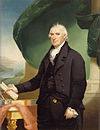
|
George Clinton
|
March 4, 1805 – April 20, 1812
|
President of the Senate
|

|
William H. Crawford
|
April 20, 1812 – March 4, 1813
|
President pro tempore
|
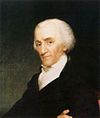
|
Elbridge Gerry
|
March 4, 1813 – November 23, 1814
|
President of the Senate
|

|
John Gaillard
|
November 25, 1814 – March 4, 1817
|
President pro tempore
|

|
Daniel Tompkins
|
March 4, 1817 – March 4, 1825
|
President of the Senate
|

|
John C. Calhoun
|
March 4, 1825 – December 28, 1832
|
President of the Senate
|

|
Hugh Lawson White
|
December 28, 1832 – March 4, 1833
|
President pro tempore
|

|
Martin Van Buren
|
March 4, 1833 – March 4, 1837
|
President of the Senate
|
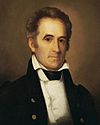
|
Richard Mentor Johnson
|
March 4, 1837 – March 4, 1841
|
President of the Senate
|

|
John Tyler
|
March 4 – April 4, 1841
|
President of the Senate
|

|
Samuel L. Southard
|
April 4, 1841 – May 31, 1842
|
President pro tempore
|
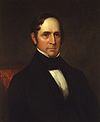
|
Willie P. Mangum
|
May 31, 1842 – March 4, 1845
|
President pro tempore
|

|
George M. Dallas
|
March 4, 1845 – March 4, 1849
|
President of the Senate
|

|
Millard Fillmore
|
March 4, 1849 – July 9, 1850
|
President of the Senate
|
| Vacant July 9–11, 1850[a]
|

|
William R. King
|
July 11, 1850 – December 20, 1852
|
President pro tempore
|

|
David Rice Atchison
|
December 20, 1852 – March 4, 1853
|
President pro tempore
|
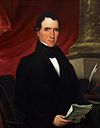
|
William R. King
|
March 4 – April 18, 1853
|
President of the Senate
|

|
David Rice Atchison
|
April 18, 1853 – December 4, 1854
|
President pro tempore
|
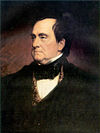
|
Lewis Cass
|
December 4, 1854
|
President pro tempore
|
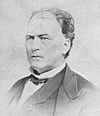
|
Jesse D. Bright
|
December 5, 1854 – June 9, 1856
|
President pro tempore
|

|
Charles E. Stuart
|
June 9–10, 1856
|
President pro tempore
|

|
Jesse D. Bright
|
June 11, 1856 – January 6, 1857
|
President pro tempore
|

|
James Murray Mason
|
January 6 – March 4, 1857
|
President pro tempore
|

|
John C. Breckinridge
|
March 4, 1857 – March 4, 1861
|
President of the Senate
|

|
Hannibal Hamlin
|
March 4, 1861 – March 4, 1865
|
President of the Senate
|

|
Andrew Johnson
|
March 4 – April 15, 1865
|
President of the Senate
|
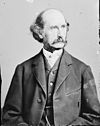
|
Lafayette S. Foster
|
April 15, 1865 – March 2, 1867
|
President pro tempore
|
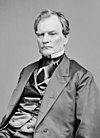
|
Benjamin Wade
|
March 2, 1867 – March 3, 1869
|
President pro tempore
|
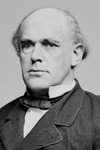
|
Salmon P. Chase
|
March 13 – May 26, 1868
|
Chief Justice
(Impeachment trial of Andrew Johnson)
|

|
Schuyler Colfax
|
March 4, 1869 – March 4, 1873
|
President of the Senate
|

|
Henry Wilson
|
March 4, 1873 – November 22, 1875
|
President of the Senate
|
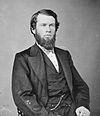
|
Thomas W. Ferry
|
November 22, 1875 – March 4, 1877
|
President pro tempore
|
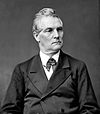
|
William A. Wheeler
|
March 4, 1877 – March 4, 1881
|
President of the Senate
|

|
Chester A. Arthur
|
March 4 – September 19, 1881
|
President of the Senate
|
| Vacant September 19 – October 10, 1881[b]
|

|
Thomas F. Bayard
|
October 10–13, 1881
|
President pro tempore
|

|
David Davis III
|
October 13, 1881 – March 3, 1883
|
President pro tempore
|

|
George F. Edmunds
|
March 3, 1883 – March 3, 1885
|
President pro tempore
|

|
Thomas A. Hendricks
|
March 4, 1885 – November 25, 1885
|
President of the Senate
|
| Vacant November 25 – December 7, 1885[c]
|

|
John Sherman
|
December 7, 1885 – February 26, 1887
|
President pro tempore
|

|
John James Ingalls
|
February 26, 1887 – March 3, 1889
|
President pro tempore
|
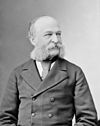
|
Levi P. Morton
|
March 4, 1889 – March 4, 1893
|
President of the Senate
|

|
Adlai E. Stevenson I
|
March 4, 1893 – March 4, 1897
|
President of the Senate
|

|
Garret Hobart
|
March 4, 1897 – November 21, 1899
|
President of the Senate
|

|
William P. Frye
|
November 21, 1899 – March 4, 1901
|
President pro tempore
|
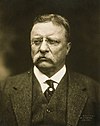
|
Theodore Roosevelt
|
March 4 – September 14, 1901
|
President of the Senate
|

|
William P. Frye
|
September 14, 1901 – March 4, 1905
|
President pro tempore
|

|
Charles W. Fairbanks
|
March 4, 1905 – March 4, 1909
|
President of the Senate
|

|
James S. Sherman
|
March 4, 1909 – October 30, 1912
|
President of the Senate
|

|
Augustus Octavius Bacon
|
October 30 – December 15, 1912
|
President pro tempore
(rotating)
|
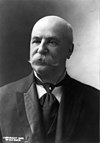
|
Jacob Harold Gallinger
|
December 16, 1912 – January 4, 1913
|
President pro tempore
(rotating)
|

|
Augustus Octavius Bacon
|
January 5–18, 1913
|
President pro tempore
(rotating)
|

|
Jacob Harold Gallinger
|
January 19 – February 1, 1913
|
President pro tempore
(rotating)
|

|
Augustus Octavius Bacon
|
February 2–15, 1913
|
President pro tempore
(rotating)
|

|
Jacob Harold Gallinger
|
February 16 – March 4, 1913
|
President pro tempore
(rotating)
|
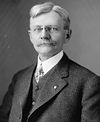
|
Thomas R. Marshall
|
March 4, 1913 – March 4, 1921
|
President of the Senate
|
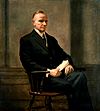
|
Calvin Coolidge
|
March 4, 1921 – August 2, 1923
|
President of the Senate
|
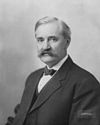
|
Albert B. Cummins
|
August 2, 1923 – March 4, 1925
|
President pro tempore
|

|
Charles G. Dawes
|
March 4, 1925 – March 4, 1929
|
President of the Senate
|

|
Charles Curtis
|
March 4, 1929 – March 4, 1933
|
President of the Senate
|

|
John Nance Garner
|
March 4, 1933 – January 20, 1941
|
President of the Senate
|

|
Henry A. Wallace
|
January 20, 1941 – January 20, 1945
|
President of the Senate
|
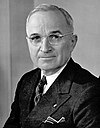
|
Harry S. Truman
|
January 20 – April 12, 1945
|
President of the Senate
|
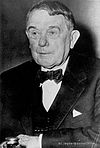
|
Kenneth McKellar
|
April 12, 1945 – January 4, 1947
|
President pro tempore
|

|
Arthur H. Vandenberg
|
January 4, 1947 – January 3, 1949
|
President pro tempore
|

|
Kenneth McKellar
|
January 3–20, 1949
|
President pro tempore
|

|
Alben W. Barkley
|
January 20, 1949 – January 20, 1953
|
President of the Senate
|

|
Richard Nixon
|
January 20, 1953 – January 20, 1961
|
President of the Senate
|

|
Lyndon B. Johnson
|
January 20, 1961 – November 22, 1963
|
President of the Senate
|

|
Carl Hayden
|
November 22, 1963 – January 20, 1965
|
President pro tempore
|

|
Hubert Humphrey
|
January 20, 1965 – January 20, 1969
|
President of the Senate
|

|
Spiro Agnew
|
January 20, 1969 – October 10, 1973
|
President of the Senate
|
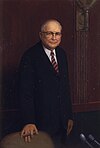
|
James Eastland
|
October 10 – December 6, 1973
|
President pro tempore
|

|
Gerald Ford
|
December 6, 1973 – August 9, 1974
|
President of the Senate
|

|
James Eastland
|
August 9 – December 19, 1974
|
President pro tempore
|

|
Nelson Rockefeller
|
December 19, 1974 – January 20, 1977
|
President of the Senate
|

|
Walter Mondale
|
January 20, 1977 – January 20, 1981
|
President of the Senate
|

|
George H. W. Bush
|
January 20, 1981 – July 13, 1985
|
President of the Senate
|

|
Strom Thurmond
|
July 13, 1985[d]
|
President pro tempore
|

|
George H. W. Bush
|
July 13, 1985 – January 20, 1989
|
President of the Senate
|
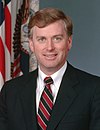
|
Dan Quayle
|
January 20, 1989 – January 20, 1993
|
President of the Senate
|

|
Al Gore
|
January 20, 1993 – January 20, 2001
|
President of the Senate
|

|
William Rehnquist
|
January 7 – February 12, 1999
|
Chief Justice
(Impeachment trial of Bill Clinton)
|

|
Dick Cheney
|
January 20, 2001 – June 29, 2002
|
President of the Senate
|

|
Robert Byrd
|
June 29, 2002[e]
|
President pro tempore
|

|
Dick Cheney
|
June 29, 2002 – July 21, 2007
|
President of the Senate
|

|
Robert Byrd
|
July 21, 2007[f]
|
President pro tempore
|

|
Dick Cheney
|
July 21, 2007 – January 20, 2009
|
President of the Senate
|

|
Joe Biden
|
January 20, 2009 – January 20, 2017
|
President of the Senate
|

|
Mike Pence
|
January 20, 2017 – January 20, 2021
|
President of the Senate
|
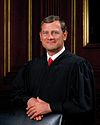
|
John Roberts
|
January 16, 2020 – February 5, 2020
|
Chief Justice
(First impeachment trial of Donald Trump)
|

|
Kamala Harris
|
January 20, 2021 – November 19, 2021
|
President of the Senate
|

|
Patrick Leahy
|
November 19, 2021[g]
|
President pro tempore
|

|
Kamala Harris
|
November 19, 2021 – present
|
President of the Senate
|




















































































